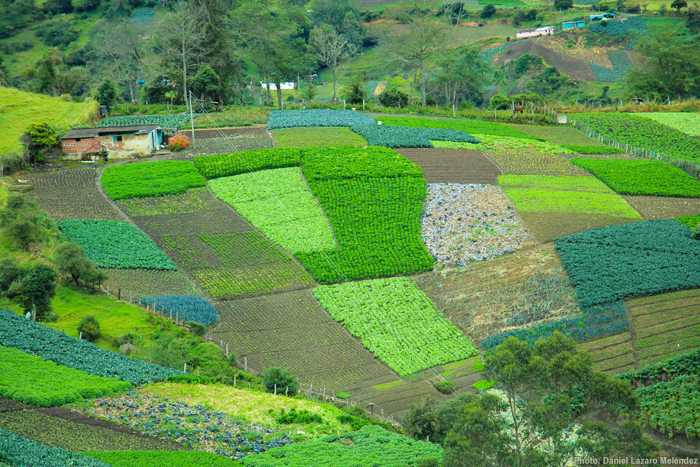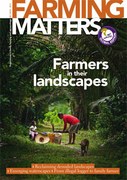Leading up to the December 2014 Global Landscapes Forum in Peru, this issue explores how family farming, pastoralist and forest communities are responding to the increasing pressures on their landscapes, creating space for their own development path and reconstructing their landscapes.
The ‘landscape approach’ has been increasingly promoted during recent years as a new perspective for addressing global problems. In the face of increasing and competing claims on the land, planners, scientists and policy makers have realised that sectoral approaches do not work. ‘Integrated land management’ or broad landscape level considerations have at last begun to supersede those restricted to water, forests, farming, etc., in national policies and development programmes.
The landscape approach promises to tackle the negative effects single sectors may have on the others when left to grow on their own, and it also promises to deliver complementary benefits by integrating different landscape elements. This holds the potential to improve livelihoods, food security, well being, climate change adaptation and delivering ‘environmental services’. But some serious challenges still remain in reconnecting agriculture to other functions of the landscape, and especially in finding a balance of interests in the face of unequal power relations.
Connecting to the landscape
For many family farmers, pastoralists, forest communities and fisherfolk, a holistic ‘landscapes perspective’ is not new. Their landscapes have always been shaped in dynamic interaction with others and the natural environment.
The interdependencies between different components are a given, and a logical daily reality that relates closely to the interdependencies within families and the communities they live in. Landscapes not only provide food, fodder, fuel, timber and medicine, but they also have cultural and religious significance. They are where people live, and provide the fundamental framework to all aspects of life.
Each person holds his or her own specific knowledge and perspectives about different parts of the landscape. She or he works with whatever is available in terms of highland or lowland, water sources, seeds, trees and so on, through practices that have been built up and continue to develop over generations. Women and men may use different pieces of farmland or forest for different purposes, and their animals may get a separate patch to graze. Such landscape elements are combined to fulfil various roles, often strengthening each other and the system as a whole but there is bound to be competition as well. Through these and other activities, family farmers maintain landscapes, many of which have been recognised as culturally and environmentally valuable.
Many communities however risk losing the knowledge and practices that make the landscape connection. For more than half a century, policy makers, extensionists and researchers have pushed hard for modern farming, promising that this would improve the lives of all. Production and livelihoods were seen as individual units in isolation from their environment. Focus was on maximizing productivity at farm level, and farmers were to specialise in single crops and seek growth in external, rather than their own, inputs and knowledge. Though this focus on single crops and farms may have contributed to short or medium term gains, in the long run it has contributed to degradation of landscapes and to unsustainable farming systems. In this issue we find several illustrations of such processes.
Finding balance in power
The landscape approach is hailed as inclusive, equitable and multi-stakeholder, as a new way of addressing and resolving conflicts in land and water management, but as practice shows, it is clear that the challenge of power remains.
While in some cases, such processes have resulted in agreements acceptable to all parties, all too often a seat at the table is not enough. Family farmers, local forest users and fisherfolk are confronted with powerful political and commercial interests. Even when facilitated in a fair and skilful way that addresses inherent power imbalances, the real decisions may be made behind closed doors. Or these communities are excluded from other land governance structures, natural resource management programmes or policy development that may be more decisive. This is especially the case when landscape perspectives and demands are in serious conflict, as is the case with mining or fracking. In such situations, real landscape democracy appears to be little more than rhetoric.
Reconnecting
Even when facing hugely un-level playing fields, farmers in the broadest sense, i.e. who may depend on crops, animals, trees, fish or other natural resources, are finding ways to score goals while running uphill. Where possible, they are taking control to ensure that they make the decisions about what happens in their territories. This issue of Farming Matters presents a selection of these experiences, concluded by a ten-year reflection on integrated landscape approaches .
Farmers have reconstructed and reconnected with landscapes often by building on local knowledge as a starting point for further development and innovation. We see them using their traditional knowledge in India and organising themselves into an effective ‘landscape powerhouse’. In Nepal, biodiverse farming systems come to the rescue when their orange orchards are killed by a disease. Farmers turn to the water when climate change threatens their land in Bangladesh (page 18), and take up new knowledge to make the most of invasive trees in Djibouti . As argued eloquently by Million Belay (page 21), knowledge and historical memory that exist in communities are highly inspirational in this regard. John Liu also tells us about how we need more farmers in the landscape, not less , and Jeff Campbell explains that how they organise themselves into effective organisations is key.
These family farmers, pastoralists and forest communities have used the space they have as effectively as they can. They have also managed to expand it, amplify their voice and assert their rights by organising themselves and by forging alliances. In the Netherlands, farmers formed territorial cooperatives and collaborated with scientists and civil society to change policies and implement a self-governing landscape structure .
As we see from the experiences presented here, creating a political space for family farmers and community organisations is of crucial importance, while efforts should be made to harness women’s rich knowledge and organising capacity.
This issue of Farming Matters is a call for those involved to challenge top-down concepts that frame today’s landscape approach. But we should not seek an alternative. Rather, we must provide a better platform for those who need to be heard – the real managers of the land, our landscapes. Only with them can we shape a sustainable future.
Edith van Walsum and Nick Pasiecznik
Edith van Walsum is director of ILEIA – The centre for learning on sustainable agriculture. Nick Pasiecznik is editor of Farming Matters. ILEIA is also the secretariat of the global AgriCultures Network.


